A couple of weeks ago Al Ciampa, SFG wrote an excellent blog entitled “Where Do You Go After Simple.” In it he outlined a “serious endurance” swing protocol. I strongly recommend it to those who want to take their conditioning to the next level.
If you choose to hold the course to the “sinister” goal while sticking to “easy endurance” type training, here is another option.
As Simple as Possible, But Not Simpler
Albert Einstein famously quipped, “Everything should be made as simple as possible, but not simpler.” I pushed Kettlebell Simple & Sinister (S&S) programming to the very edge of its statement, to the verge of being too simple. I have done it on purpose, in order to eliminate any possible excuses you might have for non-compliance.
I intentionally removed load variability or “waviness,” as Russians call it. Just bang out your 100 daily swings and 10 get-ups, like brushing your teeth. All of your attention is on technique and power, and zero brain cells need to be involved in analyzing your workout, attempting to change it.
Once you have put in your time and effort, and reached the “simple” goals — 16kg for get-ups and 24kg for swings for ladies; and 32kg in both events for gents for the specified sets, reps, and times — you may carry on using the same simple template inspired by old-time strongmen.
Or, you may start “waving” your volume in the manner of Soviet weightlifters. Multiple studies have documented the greater effectiveness of “waved” training for experienced athletes.
How to “Wave” Simple & Sinister-Style Training
The first step is identifying your monthly volume. Note that the “month” I am referring to is not a calendar month but a block of four weeks. S&S is intended to be practiced daily but most people end up doing it five days a week. For swings, the numbers then add up to:
(5 days x 100 reps = 500 reps a week) x 4 weeks = 2,000 reps a month
When the training load is static, every week makes up 25% of the monthly total. “Waviness” describes the pattern of making some weeks’ number of lifts (NL) greater than this average, and other weeks’ NL smaller. Soviet weightlifting specialists proposed the following classification:

Many successful combinations of percentages have been arrived at through painstaking experimentation by the Soviets. We shall go with 15, 20, 30, 35%. These percentages are named, respectively, deloading, maintenance, developmental, and stress-developmental.
With a 2,000-rep monthly total we arrive at 300, 400, 600, and 700 reps per week. Again, waviness means making the volume of some training periods both greater than and less than the average, while maintaining the same average.
Note that the weeks do not have to be arranged in the above order. Experiments have demonstrated any order to be effective for different reasons. 300-700-400-600, 400-600-300-700, or any other combination of these four numbers, will make you stronger. So just pick one, and make sure to use a different one next month.
Your choice can be random, or influenced by your plans. For instance, if you are climbing a mountain on week two and want to do a bare minimum of swings, assign the lowest NL, 300, to that week. Or, if you have a competition in your sport on week four, then taper the volume towards that week: 700-600-400-300. Make the week after Thanksgiving the highest volume week of the month. You get the idea.
When you are planning two months back to back, make that you do not use the same NL in the last week of the first month and the first week of the second month.
Due to the fractal nature of this type of planning, you must also vary the volume within a week. Use the table below. Note that the number of training sessions changes depending on the week’s volume. This was a standard operating procedure for Soviet weightlifters on whose methodology the “From Simple to Sinister” program is based.
As with weeks, any order of the above percentages is acceptable for different reasons, and should be varied. Make sure the NL on the last day of one week does not match that of the first day of the next week.
3-Month “From Simple to Sinister” Program Outline
To make your life easy, I have written up the first three months of your “From Simple to Sinister” swing training:
For your training load on “From Simple to Sinister,” you will use the next kettlebell up from the one that allows you to do 100 swings in five minutes, on any day—the one that you “own.” Go up 4kg for ladies and 4 or 8kg for gents. E.g., a lady who has reached the “simple” goal with 24kg should swing 28kg. A gent who has bagged 32kg should train with 36kg or 40kg. (Or both, but that would complicate the planning.)
There is no need to time your rest periods, except on the test days appearing in the last week of every month. Just rest long enough to maintain maximal power output. Obviously, 180 reps will demand longer rest periods than 80.
As in the original S&S template, on days when you are dragging your tail, do two-hand “shadow swings” with a kettlebell close to 30% of your bodyweight or lighter. Soviet weightlifting specialists discovered that cutting back on weight and focusing on speed-strength “creates favorable conditions for recovery processes in the body.” (Chernyak, 1978)
On the last Friday of each month, test yourself with a timer going off every thirty seconds. If you feel your power about to drop off, switch to a lighter kettlebell for the rest of the 100 reps. If you are still going strong after 100 with the target weight, keep going as long as your power does not fade.
If you have made 100 in five minutes with confidence and power, increase the weight next month. If you did not make it to 100, or, you did but it took a great effort, stay with the weight for another four weeks.
There are no bimonthly two-handed swing tests on the “From Simple to Sinister” plan.
The Ideal Practitioner for “From Simple to Sinister”
This plan was designed for someone who does exclusively swings (and goblet squats at the beginning of each session) for the lower body. If you want to figure out how to introduce another squat or hinge into the mix, you are on your own.
You can continue training the get-up in the usual S&S manner: five singles per arm almost every day. Or, if you feel up for it, add variability to your get-up training using the swing plan as a template. Note that the volume dynamics for different lifts are independent. In other words, a 30% week or day for swings can correspond to 15, 20, 30, or 35% for the get-up. Do not try to introduce a pattern (e.g. making them go up in sync or at counterphases) where there should be none.
If you are interested in the logic and wisdom behind this type of Soviet weightlifting based programming and how to apply it to your strength lifts, the Plan Strong™ seminar is right up your alley.
More power to you.
Have you read and applied Kettlebell Simple & Sinister?
Please review it on Amazon.


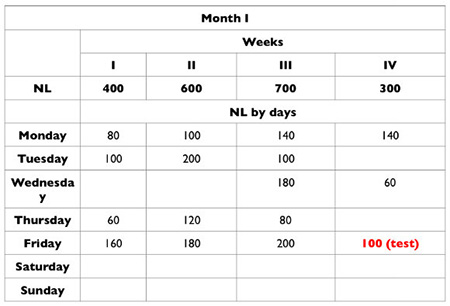
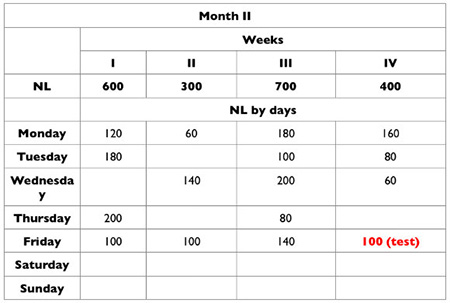
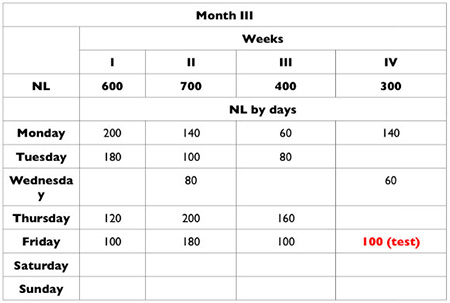
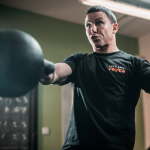
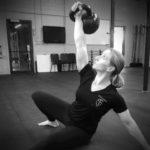



Would this plan work for me given my travel schedule?I have reached the simple goal with the 32 KG. Starting to work with the 40KG. However, I travel 1-2 weeks each month and I do what I can at the hotel gyms. I fly so I cant pack a bell.
Current progression:
20 sets of 5 swings with 40KG with HR monitor on.
start each set <= 115 bpm and not exceed 145
Getups – 40KG with HR monitor on.
Goal is to move to 14 sets of 7 reps after I am able to compress rest periods comfortably and ultimately 10 x 10.
Thoughts please and thanks!!
specs: 47 yr old, 210 lbs
Mighty fine read as always.
I have completed S&S goals with the 40 kg bell.
That means using a 48 kg bell for the specified NL in the monthly template, correct?
200 swings with a 48 kg bell….simple but not easy, definitely longer rest period those days.
I’ve been working with the 32kg bell for several weeks now and I’m having some difficulty compressing my rest periods. Would applying the above template to my situation be a good solution?
Hi, Pavel and all of the readers.
Got to admit, I was very happy to read the “From Simple to Sinister” article.
For those, who wont readthe whole post—— OH BOY- THIS PROGRAM DOES DELIVER…
NOW I KNOW- WHAT THE HELL EFFECT – that’s what it is. No explanations- but it does deliver.
I had been stucked with “S & S” 36kg One Arm swings for a few months, could not progress to 10 swings in every 30 seconds, best i could do was- 10 Swings – 20 sec rest, so 20sec/20sec (Work/Rest).
So, without thinking I jumped to the new program. It was not easy, especialy the 180 and 200 swing days, but I kept the Rest period longer, 45-55seconds, or sometimes I split my 200 Swing session in 2 parts, part 1 done in beginning of the workout and part 2 at the end.
I naturally had more Swinging Power in the beginning of the workout, but also I could keep it my rest periods naturaly shorter at the end of my training session. So go figure.
Now, after first 2 months on this program, I just Tested last Friday- and I did-
100 Swings in 5 minutes and then additional 30 Swings in 1 min 20 seconds.
TOTAL- 130 SWINGS IN 6 MIN 20 SEC.
THANK YOU PAVEL FOR THE EXCELLENT AND YET, SIMPLE AS USUAL, BUT VERY EFFECTIVE PROGRAM…..
Vilnis
Great to hear, Vinis, thanks for reporting!
I was hoping to get some insight as to the ideal training program to achieve S&S such as using the “waving volume” but also continue a strength routine for other lifts such as following an Easy Reg Park program? The waving volume helps build up to heavier swings in 5 mins but requires 3-5 days of different volume sessions over monthly periods with testing the 5 min lift at end of month. If following the waving volume program, how can I incorporate other lifts for overall strength training without overtraining?
Thanks
I got this book too. I was doing 60reps (3 sets of 20) using 20kg . My heart pump rate was going very high , literally I could feel power of my heart on palm on the chest . But there was always drop of speed of each reps when going high. There is always back pain after a set
swing
http://youtu.be/C9sK0k9cJ0Y
Hi Pavel,
I have one eye on training for the SFG 1 cert sometime in the future. I have used kettlebells in and amongst various types of training in thr past but would like to master them fully. I have recently purchased the excllent S&S ebook. Great educating methods and theories as well as practices!
My question is once i have nailed comfortable and solid technique and relevant weight for both swing & TGU, What should be the next step/programme for SFG 1. I know there are many options, but this can be confusing as to what route to take.
For the mean time though I shall enjoy and try to master S&S first.
Many Thanks!
Best Regards!
Ryan
Should getups be done in the same numbers as the swings for each training session?
Never mind. I saw it.
Hi Pavel,
One thing that stuck out to me in your article is where you say “S&S is intended to be practised daily”. I doubt that is just an offhand comment by yourself. I wondered if you meant by that: for someone whose ability is “simple”, then 100 swings in 5mins and 10 TGU’s in 10min daily with the 32, or just 100 swings and 10 TGU’s with the 32, no time limit?
It is surprisingly demanding for under 15mins of physical effort.
I love the concepts within this article too, thanks. Will be something I try once I own the 32.
Pavel,
This is super interesting to me. I’ve been subconsciously waving up to the Simple standards in prep for my SFG 1 cert in April of this year, however due to the demands of training more than 2 movements, performing the Simple program as is won’t work in preparing me to pass.
Since September I started with a 20kg bell doing single hand swings, and a 16kg doing snatches. Mondays and Fridays were reserved for my medium and heavy strength training days, Wednesdays were reserved for a light shakeout day where I performed some pushups and rows, along with a few pistols and some two handed shadow swings for speed. Tuesdays became my snatch day, Thursdays single arm swing day. Total volume for these days stayed at or around 200 reps, however the training density of these days increased, meaning the total time spent training decreased. I started with 5 and 5 (10 total on the minute for 20 minutes, total of 200 swings or snatches). Every week I increase one rep. 5 weeks went by, I’d moved up to 200 in 10 with what felt like minimal effort.
After I completed my goal with the 16 and 24 for snatches and swings, I took just over a week off from that program and then started again with the next bell, going to 20kg and 28kg respectively. Some bumps in the road (namely a cranky SI joint) prevented me from increasing as quickly as I would have liked, but here I am 8 weeks later and I’ve gone 200 in 10 with each of those bells also. Grip strength has markedly improved.
The snatch test bell is a tough mother for me as my grip gives out far before my legs and lungs. But SA swinging the 32 has been helping with that.
The point of this post is that I see some parallels here (I’ve read SandS, just not delved in to it fully because of my SFG 1 prep), and I’m feeling the effectiveness of waving up the loads gradually, even though my volume may be staying roughly the same throughout on these swing and snatch days.
Thank you for all that you have brought to my training, Pavel. I hope one day I might shake your hand.
Bret
Thank you, Bret!
Pavel, I can do the 24kg Swing and the 24kg TGU but I can’t keep it for 5 days in a row, I feel exhausted. How should I proceed? I’ve tried to keep one rest day but is not enough.
Thank you.
Sara.
Sara, have you built up to where you are in the manner described in S&S? How long does it take you to get your 100 swings?
Pavel,
Before starting my S&S Training, I already made the one arm swings, so when I tested the Simple goals I could do it. Even making them, I’m still training with only 24 kg to improve my technique and endurance. In two weeks I’ll start the progression to 32 kg. So, no, I didn’t build up the Simple part as it is described in the book, I tried to adapt to what I was already able to do.
The TGU is taking longer than 10 minutes with 24 kg, sometimes I think I need to build more muscles. My goal is to achieve the 10 minutes in 3 weeks.
Thank you very much for your attention, Sir!
Sara
Sara, scale back to 4 days a week for now but do not progress so fast to be able to recover overnight.
Pavel,
I just wanted to let you know that I completed the S&S!! After 10 weeks I achieved the Sinister!
In the beginning I thought I could never do it, because it is half my body weight! But I did! And I’d like to thank you, sir!
I just can’t explain all my happiness and satisfaction. I can tell you I’m not the same Sara from 10 weeks ago, this Program taught me so much, this is not only about how to swing a big bell (I call it “The Beauty”) but it is about how to persist and how to make a dream come true! It is also about consistency and obstinacy to become a stronger person.
I’ll be in Chicago next May, and would be a great honor shake your hand and have your signature in my book!
Thank you again,
Sara.
Jorge, one thing at a time; reach the “sinister” level first.
Fantastic article, I’m with the 36Kg in this moment. I arrive here with the 100 reps 6/7 days per week protocol, but I can only train 4 days now so it’s perfect for my current situation. My question is after somebody achieves the sinister standard, what is next? Is it worth to go with a bigger KB or is this area of diminishing returns? Thanks
Jorge
Hi Jorge,
Take a look at this article:
http://www.strongfirst.com/things-are-going-so-well-help-me-screw-it-up-part-2/
Regards
This is a great article. Very timely to me as well as I just hit 5 min for my 32 kg swings yesterday. But there’s something so fantastic about the simplicity of 100 swings a day, I just can’t bear to switch.
Thanks, Chris, and do not switch.
Excellent article Chief! I hope you’ll come soon in Italy to explain us the Plan Strong method…power to Strongfirst!
Thank you, Simone!
I might be teaching Plan Strong in Italy; should know for sure in a couple of weeks.
I hope so! Your speech at the second edition of Italian Strength Convention has made my mouth water about it…
This looks like a powerful progression! Thank you for sharing!
Chief, can this “swing program” be compatible with one of your Press/Pullup Programs (e.g. ROP style ladders, or experimental). If so, can they be done on the same day? Thank you in advance.
Louka, press, easily; pullups would take careful planning, given the grip stress from swings.
Can i use waviness to reach the simple goals?
Paolo, no; follow the instructions in the book.
pavel love the book your the best !
Thanks, Noe!
Great article that is simple…however, as always we tend to make it harder. Help a comrade out! As to the set/rep scheme, are we to still use the 10 sets and adjust the reps per set according to the program reps for the day?
LY, still 10 reps.
are we talking rep totals, or per arm. SO NL per session could be 100 ea arm, or total swings?? Thanks.
Buy the book an have a look………… hey i’m a poet.
Seriously, S & S is 10 by 10 swings & 10 by 1 get ups. So it’s 100 swings in total.
Ryan, total.
Thanks, Sir.
Amazingly insightful, Pavel. You simplify and the program gets stronger! Outstanding work!
Thanks, Mark!
I will urgently purchase something from Daniel Kahneman on Amazon. You, Pavel, make me even stronger but my mind is treatening to remain weaker. As a spoon directly into the mouth.
But, hank you, tastes good!
Best regards!
Ugis, I enjoy Kahneman’s work but what does it have to do with this blog?
Your instructions are so complete that I do not need to employ my mind. DK should help me compensate this lack).
Ugis, roger that ;]
This is excellent–concise and very informative.Thankyou for sharing.
In your Cost of Adaptation article,you mentioned specializing in bodyweight combined w/ Simple and Sinister.
How many bodyweight days would you recommend(pushups,pullups,pistols,lever practice) to avoid burnout in this new programming you outlined?Thankyou for reading and for your help.
Thanks, sf. Two to three.